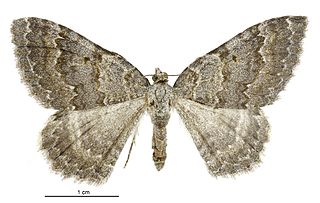
Amata is a genus of tiger moths in the family Erebidae. The genus was erected by Johan Christian Fabricius in 1807.

Epyaxa sodaliata, the sodaliata moth, is a moth of the family Geometridae. The species was first described by Francis Walker in 1862 and it is native to Australia.

Epyaxa subidaria, the subidaria moth, is a moth of the family Geometridae. The species was first described by Achille Guenée in 1857 and it is native to Australia, including Tasmania.

Asaphodes is a genus of moths in the family Geometridae erected by Edward Meyrick in 1885. This genus is endemic to New Zealand and species within this genus are found throughout New Zealand including the North, South and Stewart / Rakiura Islands.

Austrocidaria is a genus of moths in the family Geometridae. It was described by John S. Dugdale in 1971.

Casbia is a genus of moths in the family Geometridae erected by Francis Walker in 1866.

Chalastra is a genus of moths in the family Geometridae first described by Francis Walker in 1862.

Chrysolarentia is a genus of moths in the family Geometridae erected by Arthur Gardiner Butler in 1882. It is mainly found in Australia with one species found also in New Zealand.

Dichromodes is a genus of moths in the family Geometridae first described by Achille Guenée in 1857.

Poecilasthena is a genus of moths in the family Geometridae.

Syneora is a genus of moths in the family Geometridae erected by Alfred Jefferis Turner in 1917. All the species are found in Australia.

Taxeotis is a genus of moths in the family Geometridae described by Edward Guest in 1887. All the species in this genus are found in Australia.

The Oecophorinae are the nominate subfamily of moths in the concealer moth family (Oecophoridae). They are part of the insufficiently studied superfamily Gelechioidea, and like their relatives, the circumscription of this taxon is disputed.

Oenochrominae is a subfamily of the moth family Geometridae.

Desmobathrinae is a subfamily of the moth family Geometridae described by Edward Meyrick in 1886.

Xyloryctidae is a family of moths contained within the superfamily Gelechioidea described by Edward Meyrick in 1890. Most genera are found in the Indo-Australian region. While many of these moths are tiny, some members of the family grow to a wingspan of up to 66 mm, making them giants among the micromoths.
Sagalassa is a genus of moths in the family Brachodidae.

Xanthorhoe orophyla is a moth of the family Geometridae. It is endemic to New Zealand and is found in the South Island in alpine habitat. This species has one brood a year and their larvae feed on cruciferous plants. Adults are on the wing from December to February and are attracted to light.

Gingidiobora subobscurata is a species of moth in the family Crambidae. It is endemic to New Zealand. This species has been classified as "At Risk, Declining" by the Department of Conservation.


















